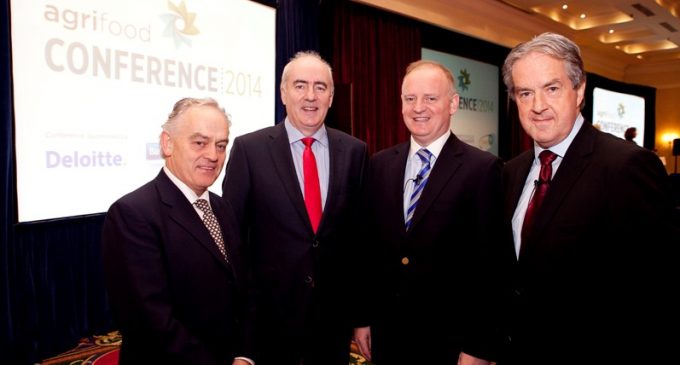Positive Outlook For Irish Agrifood if Sustainable Long-term Investment Can be Achieved

Top food industry executives, banking strategists, and farming interests gathered in Dublin recently for the AgriFood Business Partners conference to explore sustainable investment options for the future growth and development of Ireland’s Agrifood industry. The AgriFood Business Partners Conference is designed to frame a medium term approach to sustainable investment in the Irish agrifood sector up to 2020. 400 delegates attended the event.
Cathal Fitzgerald, Finance Director, AgriFood Business Partners said: “The growth potential forecast in various commentaries can have an extremely beneficial effect on Ireland’s economic growth, rural development, employment levels and national balance of payments, if managed correctly. However, if mismanaged it could lead to unrealistic expectations at market, primary producer and financial institution levels with Ireland not fully exploiting this wonderful opportunity.”
The Agrifood industry is critically important as a domestic driver of economic growth. It provides primary employment for 170,000 people or 8.8% of Irish employment. There are 140,000 family farms with gross output of €7 billion and 1,200 companies in the sector with a turnover of some € 26 billion. These companies spend 74% of their input requirements on Irish sourced inputs compared to 40% generally by manufacturing companies overall. Food and drink exports have increased by 40% since 2009 to €10 billion last year with 42% of Irish exports going to the UK, 32% to the EU and 26% worldwide.
Agrifood, fisheries and forestry represent Ireland’s largest indigenous industry and have a key role to play in Ireland’s economic recovery. This is acknowledged in the Government’s Food Harvest 2020 strategy which has set aggressive growth targets by 2020:
The value of primary output is targeted to increase by €1.5 billion with value added outputs to increase by €3 billion and exports overall targeted to increase to €12 billion. It is envisaged that the growth agenda will be delivered across the key sectors: Dairy, Meat & Livestock (Beef, Lamb, Pigs, Poultry), Prepared Ready Meals, Beverages, Seafood, Edible Horticulture and Cereals.
The dairy sector, at €3.045 billion, is slightly smaller than Meat & Livestock at €3.075 billion (Bord Bia, 2013). Bord Bia is targeting a 50% increase in output with the abolition of milk quotas in 2015 and the expectation that Ireland’s perceived competitive advantage in pasture based production can be profitably exploited.
It is anticipated that the pasture based model, also the norm for both beef (and sheep), offers the potential for Irish in-market product differentiation based on genuine green credentials.
Prepared ready meals (with 2013 exports of €1.65 billion) and beverages (with an export value of €1.25 billion) are both of major significance to the economy while seafood is considered to have huge growth potential, albeit from a modest base with an export value of €520 million in 2013.
The Food Harvest 2020 Dairy Activation Committee recommended the following with respect to Funding: ‘The growth proposition must be shaped into a realistic and professional business case with a financial structure that is capable of attracting investment and financial support from banks, venture capitalists, government agencies and suppliers in an optimum mix that enables profitable growth to continue.’
While this comment was specific to dairy it is equally relevant across most sectors of the agri-food industry:
“Long term assets are required for long term resource development,” said Cathal Fitzgerald, Finance Partner of AgriFood Business Partners. “Working capital sources are needed that reflect the risk nature of the sector and provide solutions for extended credit, taking into account the seasonality of production and product maturation.
“The investment required to deliver this growth potential is substantial at every level of the value chain. Farm debt directly related to farming activities is currently estimated at €1.9 billion (Teagasc National Farm Survey, 2011), while total family farm debt is of the order of €4 billion. This is against a background where financial markets, post the debt crisis, are less liquid and are much more risk adverse. There are also examples in the agri sector where the financial markets are dysfunctional.”
“There is a necessity to ensure that the mistakes made in the pre-crash Celtic Tiger boom are not repeated in the agri-food sector as expansion gathers pace. Ireland must increasingly compete in the global marketplace where every facet of competitiveness – from land cost to manufacturing and marketing efficiency – are critical to sustainable investment and development,” said Fitzgerald.
CAPTION:
Pictured at the conference from left are: Tom Moran, Secretary General Department of Agriculture, Food and the Marine; Michael Cronin, Chairman AgriFood Business Partners; Kevin Lane, CEO Irish Dairy Board; and Aidan Cotter, CEO Bord Bia.
























